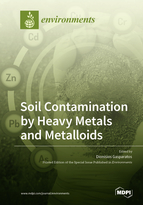Soil Contamination by Heavy Metals and Metalloids
A special issue of Environments (ISSN 2076-3298).
Deadline for manuscript submissions: closed (30 September 2020) | Viewed by 28058
Special Issue Editor
Interests: soil fertility; integrated nutrient management; soil phosphorus dynamics; organic farming; soil salinity, soil remediation; biostimulants; organic amendments; plant mineral nutrition; abiotic stress; potentially toxic elements in the soil-plant system
Special Issues, Collections and Topics in MDPI journals
Special Issue Information
Dear Colleagues,
As Guest Editor, I have the pleasure of inviting you to participate in this Special Issue of Environments covering high-impact research regarding ‘’Soil Contamination by Heavy Metals and Metalloids’’.
Heavy metals and metalloids include cadmium (Cd), lead (Pb), selenium (Se), mercury (Hg), arsenic (As), chromium (Cr), copper (Cu), nickel (Ni), silver (Ag), zinc (Zn), cesium (Cs), and cobalt (Co). Unlike organic contaminants, heavy metal(loid)s do not biodegrade and persist for a long time in the soil system.
Soil is one of the most valuable resources on earth, providing, for example, food and fiber production, climate and gas regulation, carbon sequestration, and raw materials. Soil contamination has been identified and as one of the main soil threats inducing the degradation of global soils and driving long-term losses of ecosystems services provided by them. As a result of human activities, the level of soil contamination by heavy metal(loid)s has severely increased over the last few decades and has become a worldwide environmental issue that has attracted considerable public attention.
The aim of this Special Issue is to highlight soil contamination as a global threat, providing an overview of its importance, the need for additional information from different world regions, and the urgency of developing concrete strategies to address the causes and impacts of this major threat. I especially encourage papers on the development of novel science-based methods and applications that enhance the remediation of contaminated soils and mitigate the ecological hazards caused by heavy metal(loid)s in soils.
Articles may include but are not limited to the following topics:
- The identification of the main sources of soil contamination by heavy metal(loid)s in different soil types;
- Chemistry, speciation, potential mobility, and the bioavailability of heavy metal(loid)s commonly found in contaminated soils;
- Assessment of negative impacts and risks of soil heavy metal(loid)s contamination on crop yields, soil biota, food security, and human health;
- Available methods and strategies for monitoring, assessing, and remediating contaminated soils by heavy metal(loid)s;
- Guidelines that include threshold values for heavy metal(loid)s in soils on national and regional levels.
For researchers looking to advance science in ‘’Soil Contamination by Heavy Metals and Metalloids’’, this Special Issue of Environments will provide a well-supported forum to share high-impact papers.
Dr. Dionisios Gasparatos
Guest Editor
Manuscript Submission Information
Manuscripts should be submitted online at www.mdpi.com by registering and logging in to this website. Once you are registered, click here to go to the submission form. Manuscripts can be submitted until the deadline. All submissions that pass pre-check are peer-reviewed. Accepted papers will be published continuously in the journal (as soon as accepted) and will be listed together on the special issue website. Research articles, review articles as well as short communications are invited. For planned papers, a title and short abstract (about 100 words) can be sent to the Editorial Office for announcement on this website.
Submitted manuscripts should not have been published previously, nor be under consideration for publication elsewhere (except conference proceedings papers). All manuscripts are thoroughly refereed through a single-blind peer-review process. A guide for authors and other relevant information for submission of manuscripts is available on the Instructions for Authors page. Environments is an international peer-reviewed open access monthly journal published by MDPI.
Please visit the Instructions for Authors page before submitting a manuscript. The Article Processing Charge (APC) for publication in this open access journal is 1800 CHF (Swiss Francs). Submitted papers should be well formatted and use good English. Authors may use MDPI's English editing service prior to publication or during author revisions.
Keywords
- status of soil contamination by heavy metal(loid)s on national and regional levels
- assessment of heavy metal(loid)s contamination in agricultural soils
- factors affecting heavy metal(loid)s mobility and bioavailability in soils
- heavy metal(loid)s in urban soils
- remediation strategies and techniques
- ecological risk assessment of heavy metal(loid)s in soils






